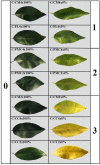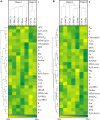Influence of Rootstock Genotype and Ploidy Level on Common Clementine (Citrus clementina Hort. ex Tan) Tolerance to Nutrient Deficiency
- PMID: 33897725
- PMCID: PMC8060649
- DOI: 10.3389/fpls.2021.634237
Influence of Rootstock Genotype and Ploidy Level on Common Clementine (Citrus clementina Hort. ex Tan) Tolerance to Nutrient Deficiency
Abstract
Nutrient deficiency, in particular when this involves a major macronutrient (N, P, and K), is a limiting factor on the performance of plants in their natural habitat and agricultural environment. In the citrus industry, one of the eco-friendliest techniques for improving tolerance to biotic and abiotic stress is based on the grafting of a rootstock and a scion of economic interest. Scion tolerance may be improved by a tetraploid rootstock. The purpose of this study was to highlight if tolerance of a common clementine scion (C) (Citrus clementina Hort. ex Tan) to nutrient deficiency could be improved by several diploid (2×) and their tetraploid (4×) counterparts citrus genotypes commonly used as rootstocks: Trifoliate orange × Cleopatra mandarin (C/PMC2x and C/PMC4x), Carrizo citrange (C/CC2x and C/CC4x), Citrumelo 4475 (C/CM2x and C/CM4x). The allotetraploid FlhorAG1 (C/FL4x) was also included in the experimental design. The impact of nutrient deficiency on these seven scion/rootstock combinations was evaluated at root and leaf levels by investigating anatomical parameters, photosynthetic properties and oxidative and antioxidant metabolism. Nutrient deficiency affects foliar tissues, physiological parameters and oxidative metabolism in leaves and roots in different ways depending on the rootstock genotype and ploidy level. The best known nutrient deficiency-tolerant common clementine scions were grafted with the doubled diploid Citrumelo 4475 (C/CM4x) and the allotetraploid FlhorAG1 (C/FL4x). These combinations were found to have less foliar damage, fewer changes of photosynthetic processes [leaf net photosynthetic rate (P net ), stomatal conductance (g s ), transpiration (E), maximum quantum efficiency of PSII (F v /F m ), electron transport rate (ETR), ETR/P net ], and effective quantum yield of PSII [Y(II)], less malondialdehyde accumulation in leaves and better functional enzymatic and non-enzymatic antioxidant systems. Common clementine scions grafted on other 4× rootstocks did not show better tolerance than those grafted on their 2× counterparts. Chromosome doubling of rootstocks did not systematically improve the tolerance of the common clementine scion to nutrient deficiency.
Keywords: Citrus; antioxidant; grafting; nutrient deficiency; oxidative stress; photosynthesis; polyploidy.
Copyright © 2021 Oustric, Herbette, Morillon, Giannettini, Berti and Santini.
Conflict of interest statement
The authors declare that the research was conducted in the absence of any commercial or financial relationships that could be construed as a potential conflict of interest.
Figures


Similar articles
-
Tetraploid Citrumelo 4475 rootstocks improve diploid common clementine tolerance to long-term nutrient deficiency.Sci Rep. 2021 Apr 26;11(1):8902. doi: 10.1038/s41598-021-88383-5. Sci Rep. 2021. PMID: 33903646 Free PMC article.
-
Nutrient Deficiency Tolerance in Citrus Is Dependent on Genotype or Ploidy Level.Front Plant Sci. 2019 Feb 11;10:127. doi: 10.3389/fpls.2019.00127. eCollection 2019. Front Plant Sci. 2019. PMID: 30853962 Free PMC article.
-
Tetraploid Carrizo citrange rootstock (Citrus sinensis Osb.×Poncirus trifoliata L. Raf.) enhances natural chilling stress tolerance of common clementine (Citrus clementina Hort. ex Tan).J Plant Physiol. 2017 Jul;214:108-115. doi: 10.1016/j.jplph.2017.04.014. Epub 2017 Apr 28. J Plant Physiol. 2017. PMID: 28478318
-
Etiology of three recent diseases of citrus in São Paulo State: sudden death, variegated chlorosis and huanglongbing.IUBMB Life. 2007 Apr-May;59(4-5):346-54. doi: 10.1080/15216540701299326. IUBMB Life. 2007. PMID: 17505974 Review.
-
Synthetic Polyploidy in Grafted Crops.Front Plant Sci. 2020 Nov 5;11:540894. doi: 10.3389/fpls.2020.540894. eCollection 2020. Front Plant Sci. 2020. PMID: 33224156 Free PMC article. Review.
Cited by
-
Meiotic Behaviors of Allotetraploid Citrus Drive the Interspecific Recombination Landscape, the Genetic Structures, and Traits Inheritance in Tetrazyg Progenies Aiming to Select New Rootstocks.Plants (Basel). 2023 Apr 12;12(8):1630. doi: 10.3390/plants12081630. Plants (Basel). 2023. PMID: 37111854 Free PMC article.
-
Transcriptome Profiling Reveals the Effects of Rootstocks on Scion Architecture in Malus domestica Borkh Var. 'Harlikar'.Plants (Basel). 2025 Feb 24;14(5):696. doi: 10.3390/plants14050696. Plants (Basel). 2025. PMID: 40094595 Free PMC article.
-
Accumulation of resveratrol, ferulic acid and iron in seeds confer iron deficiency chlorosis tolerance to a novel genetic stock of peanut (Arachis hypogaea L.) grown in calcareous soils.Physiol Mol Biol Plants. 2023 May;29(5):725-737. doi: 10.1007/s12298-023-01321-9. Epub 2023 Jun 14. Physiol Mol Biol Plants. 2023. PMID: 37363420 Free PMC article.
-
Response to Water Stress of Eight Novel and Widely Spread Citrus Rootstocks.Plants (Basel). 2025 Mar 3;14(5):773. doi: 10.3390/plants14050773. Plants (Basel). 2025. PMID: 40094758 Free PMC article.
References
-
- Afrousheh M., Ardalan M., Hokmabadi H., Afrousheh M. (2010). Nutrient deficiency disorders in Pistacia vera seedling rootstock in relation to eco-physiological, biochemical characteristics and uptake pattern of nutrients. Sci. Hort. 124 141–148. 10.1016/j.scienta.2009.12.001 - DOI
LinkOut - more resources
Full Text Sources
Other Literature Sources

